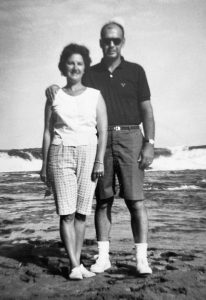Our senior staff photographer, Rick Giammaria, will celebrate his 35-year service anniversary this November. What started as a hobby at 8-years-old, has transformed into decades of commitment to one organization and countless stories of moments he’s captured in time.
In a change of scenery, Rick graciously agreed to let the spotlight shine on him during an interview in his studio. And on this August 19 – World Photography Day – we acknowledge his many contributions to Pepco Holdings and offer a glimpse into his story.
“The interest started really young – I think I was either eight or nine and I borrowed $15 from my brother so that I could buy a camera – just because I had an interest in it. I took pictures around town. One of my favorite photos is a shot of my mother and father I took at Niagara Falls. It was just a shot, but I did this when I was eight or nine years old. I did pay my brother back the $15 too.”

After graduating from the Rochester Institute of Technology in Upstate New York, Rick packed his bags and stayed with some friends who were attending dental school at Georgetown University. What was his first time in Washington, D.C. soon became where his new roots would be planted. “It took about a week before I found a job in a custom darkroom on Capitol Hill,” he says. A former LIFE Magazine darkroom technician named George Asman mentored Rick, offering hands-on experience with the medium and extensive time in the darkroom. “George taught me a lot about the final product and what it should look like. And as a plus, he let me freelance out of there – clients would come in needing a photographer and he’d let me take jobs all over the Hill.”
Q: Do you have a favorite photo that you’ve taken? What makes it so special?
He grabs a printed black and white image that is taped to his desk and says, “It’s the only copy I have – President Reagan and Mrs. Reagan in the Oval Office. That was a freelance job.” He chuckles, “Talk about pressure situation. I was in there three, four minutes tops.”
“I remember Regan standing there, he was almost like a cardboard cutout. It was so unreal. It was ‘shoot, shoot, shoot,’ then it’s over. Get the shot, there is no second chance.”Rick Giammaria, Senior Staff Photographer
Years later, Rick responded to a job posting in the Washington Post. “I caught that ad by chance looking for a photographic assistant at Pepco. I applied, got it…and they couldn’t get rid of me after that.”

We spoke a bit about how the job has changed since he originally saw the job posting in the paper. He doesn’t believe the job itself has changed, but rather how he has completed his job has.
What was once a film-based medium, involving in-house developing of black-and-white film and printmaking soon became a digital-based job. In the early 2000s, the quality of digital photography was finally catching up to film. “As luck would have it, we had a huge oil spill at our Chalk Point Generating Plant and we had to crank out a large amount of photos very quickly,” he says. He was instructed to purchase a digital camera – and he’s never looked back.

“The ease of manipulating the images – all the things I did in the dark room for eight years – the dodging and burning, make this area darker, make this area lighter – crop this, you can do on a computer in seconds,” he says. “The process is [essentially] the same, but I don’t miss my hands in those chemicals,” he laughs.
Q: Is there anything that you wish you would’ve shot, but didn’t have the chance to?
“What I wish I had shot is the 9/11 story,” he says. That Tuesday morning, Rick grabbed his camera and ran out of Pepco’s former office building on Pennsylvania Avenue and toward the White House – he was only two blocks away. He then received a phone call and was told to return to the building. “I wish I hadn’t answered the phone that day because the shots I missed on the streets of Washington were just…,” he pauses. “I wish I had gotten those.”
We switch gears and talk about the medium of photography. Photojournalism is his passion, and he shares his admiration for Carol Guzy, a four-time Pulitzer Prize winner, and Ansel Adams’s black-and-white photos from the southwest. Before we finished our chat, I had to ask him about World Photography Day.
Q: What does World Photography Day mean to you, given your distinguished career?
“I think the whole world enjoys photography. Now it’s so accessible for everyone with their phones – it’s so easy for everyone to shoot photos,” he says. “Now you see on the news a shot that someone took that wouldn’t have been taken if it weren’t for their cell phone.”
When asked what is most enjoyable about the medium, he says, “It’s just that fraction of a second in time.” He shares that many images are often not used because of slight nuances in what’s been captured and his appreciation for video capturing the action, but “I like that instant that is grabbed by photography.”


